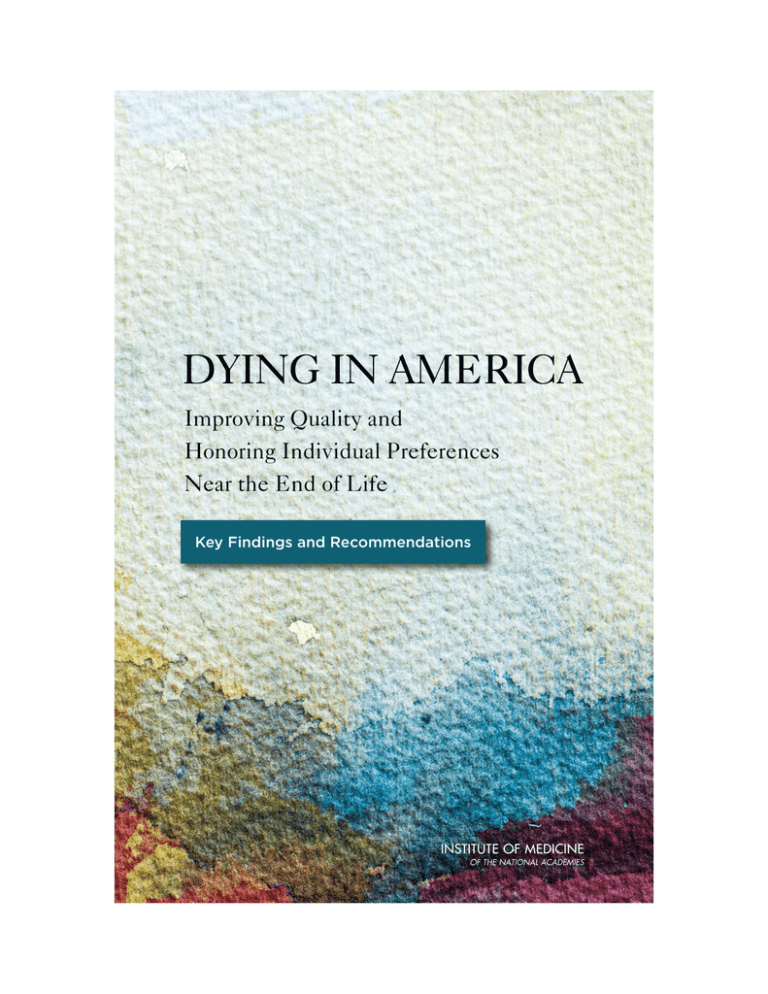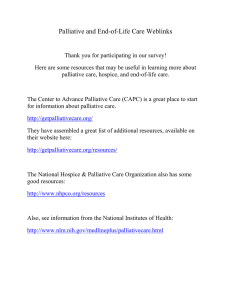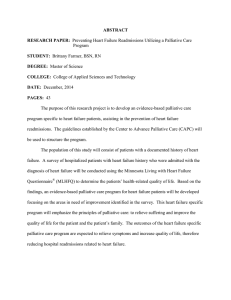
Key Findings and Recommendations
REPORT RECOMMENDATIONS
1
Introduction
For patients and their loved ones, no care decisions are more profound than those made near the end of
life. For the millions of Americans who work in or with the health care sector—including clinicians, clergy,
caregivers, and support staff—providing high-quality care for people who are nearing the end of life is a
matter of professional commitment and responsibility. Health system managers, payers, and policy makers, likewise, have a responsibility to ensure that end-of-life care is compassionate, affordable, sustainable,
and of the best quality possible.
A substantial body of evidence shows that broad improvements to end-of-life care are within reach. In
Dying in America, a consensus report from the Institute of Medicine (IOM), a committee of experts finds
that improving the quality and availability of medical and social services for patients and their families
could not only enhance quality of life through the end of life, but may also contribute to a more sustainable
care system.
This booklet contains the IOM committee’s key findings and complete recommendations.
Key Findings
Delivery of Person-Centered, Family-Oriented Care
• People nearing the end of life often experience multiple transitions between health care
settings—including high rates of apparently preventable hospitalizations—which can fragment
the delivery of care and create burdens for patients and families.
• Demand for family caregiving is increasing, and the types of tasks performed by family caregivers are expanding from personal care and household tasks to include medical and nursing tasks,
such as medication management.
• Palliative care is associated with a higher quality of life, including better understanding and
communication, access to home care, emotional and spiritual support, well-being and dignity,
care at time of death, and lighter symptom burden. Some evidence suggests that, on average,
palliative care and hospice patients may live longer than similarly ill patients who do not receive
such care.
• Although professional guidelines and expert advice increasingly encourage oncologists, cardiologists, and other disease-oriented specialists to counsel patients about palliative care, widespread adoption of timely referral to palliative care appears slow.
Clinician–Patient Communication and Advance Care Planning
• Most people nearing the end of life are not physically, mentally, or cognitively able to make their
own decisions about care. The majority of these patients will receive acute hospital care from
physicians who do not know them. Therefore, advance care planning is essential to ensure that
patients receive care reflecting their values, goals, and preferences.
• Of people who indicate end-of-life care preferences, most choose care focused on alleviating pain
and suffering. However, because the default mode of hospital treatment is acute care, advance
planning and medical orders are needed to ensure that these preferences are honored.
• Frequent clinician–patient conversations about end-of-life care values, goals, and preferences
are necessary to avoid unwanted treatment. However, most people—particularly younger, poorer,
minority, and less-educated individuals, do not have these conversations. Clinicians need to initiate conversations about end-of-life care choices and work to ensure that patient and family decision making is based on adequate information and understanding.
2
DYING IN AMERICA
• Incentives, quality standards, and system support are needed to promote improved clinician
communication skills and more frequent and productive clinician–patient conversations.
Professional Education and Development
• The establishment of specialty practice in hospice and palliative medicine is a major improvement in the education of health professionals. Three problems remain: (1) insufficient attention
to palliative care in medical and nursing school curricula; (2) educational silos that impede the
development of interprofessional teams; and (3) deficits in equipping physicians with sufficient
communication skills.
• Health professionals are not always adequately prepared to deliver “basic” or “primary” palliative
care to patients who are not currently hospitalized or do not require specialty palliative care.
Policies and Payment Systems
• Incentives under fee-for-service Medicare result in more use of services (hospital days, intensive
care, emergency care), more transitions among care settings, and late enrollment in hospice, all
of which jeopardize the quality of end-of-life care and add to its costs. In addition, payment silos
contribute to fragmentation of care, hinder coordination across providers, and encourage inappropriate utilization.
• Programs that integrate health care and long-term social services may reduce hospitalizations and
health care costs while improving patients’ quality of life. Successful models of these programs,
including methods for ensuring financial sustainability, need to be implemented more broadly.
• Palliative care services, including hospice, improve patient outcomes and may reduce health care
costs by lessening use of acute care services. Changes are needed throughout the health care system to incentivize provision of comprehensive palliative care.
• Quality standards and measures are needed to ensure that changes in payment systems, particularly those occurring under the Patient Protection and Affordable Care Act, do not adversely
affect quality of care for patients at the end of life.
Public Education and Engagement
• Need for public education and engagement about end-of-life care issues is manifest at the
societal, community/family, and individual levels. Not only do most Americans lack knowledge
about end-of-life care choices, but the health community and other leaders also have not fully
utilized strategies to make that knowledge available, meaningful, and relevant across diverse
population groups.
• Efforts are needed to normalize conversations about death and dying. Several social trends suggest that the time is right for a national dialogue on this issue, including health care consumers’
motivation to pursue high-quality care for themselves and their loved ones; a growing willingness to share stories about end-of-life care experiences that resonate across diverse groups; and
emerging leadership in local communities as well as national coalitions and collaborations.
KEY FINDINGS AND RECOMMENDATIONS
3
Recommendations
Recommendation 1: Delivery of Care
Government health insurers and care delivery programs, as well as private health insurers, should cover
the provision of comprehensive care for individuals with advanced serious illness who are nearing the
end of life.
Comprehensive care should
• be seamless, high-quality, integrated, patient-centered, family-oriented, and consistently accessible around the clock;
• consider the evolving physical, emotional, social, and spiritual needs of individuals approaching
the end of life, as well as those of their family and/or caregivers;
• be competently delivered by professionals with appropriate expertise and training;
• include coordinated, efficient, and interoperable information transfer across all providers and all
settings; and
• be consistent with individuals’ values, goals, and informed preferences.
Health care delivery organizations should take the following steps to provide comprehensive care:
• All people with advanced serious illness should have access to skilled palliative care or, when
appropriate, hospice care in all settings where they receive care (including health care facilities,
the home, and the community).
• Palliative care should encompass access to an interdisciplinary palliative care team, including
board-certified hospice and palliative medicine physicians, nurses, social workers, and chaplains, together with other health professionals as needed (including geriatricians). Depending
on local resources, access to this team may be on site, via virtual consultation, or by transfer to a
setting with these resources and this expertise.
• The full range of care that is delivered should be characterized by transparency and accountability through public reporting of aggregate quality and cost measures for all aspects of the health
care system related to end-of-life care. The committee believes that informed individual choices
should be honored, including the right to decline medical or social services.
Recommendation 2: Clinician–Patient Communication and Advance Care Planning
Professional societies and other organizations that establish quality standards should develop standards
for clinician–patient communication and advance care planning that are measurable, actionable, and
evidence based. These standards should change as needed to reflect the evolving population and health
system needs and be consistent with emerging evidence, methods, and technologies. Payers and health
care delivery organizations should adopt these standards and their supporting processes, and integrate
them into assessments, care plans, and the reporting of health care quality.
Payers should tie such standards to reimbursement, and professional societies should adopt policies that facilitate tying the standards to reimbursement, licensing, and credentialing to encourage
• all individuals, including children with the capacity to do so, to have the opportunity to participate actively in their health care decision making throughout their lives and as they approach
death, and receive medical and related social services consistent with their values, goals, and
informed preferences;
• clinicians to initiate high-quality conversations about advance care planning, integrate the
results of these conversations into the ongoing care plans of patients, and communicate with
other clinicians as requested by the patient; and
4
DYING IN AMERICA
• clinicians to continue to revisit advance care planning discussions with their patients because
individuals’ preferences and circumstances may change over time.
Recommendation 3: Professional Education and Development
Educational institutions, credentialing bodies, accrediting boards, state regulatory agencies, and health
care delivery organizations should establish the appropriate training, certification, and/or licensure
requirements to strengthen the palliative care knowledge and skills of all clinicians who care for individuals with advanced serious illness who are nearing the end of life.
Specifically,
• all clinicians across disciplines and specialties who care for people with advanced serious illness
should be competent in basic palliative care, including communication skills, interprofessional
collaboration, and symptom management;
• educational institutions and professional societies should provide training in palliative care
domains throughout the professional’s career;
• accrediting organizations, such as the Accreditation Council on Graduate Medical Education,
should require palliative care education and clinical experience in programs for all specialties
responsible for managing advanced serious illness (including primary care clinicians);
• certifying bodies, such as the medical, nursing, and social work specialty boards, and health systems, should require knowledge, skills, and competency in palliative care;
• state regulatory agencies should include education and training in palliative care in licensure
requirements for physicians, nurses, chaplains, social workers, and others who provide health
care to those nearing the end of life;
• entities that certify specialty-level health care providers should create pathways to certification
that increase the number of health care professionals who pursue specialty-level palliative care
training; and
• entities such as health care delivery organizations, academic medical centers, and teaching
hospitals that sponsor specialty-level training positions should commit institutional resources to
increasing the number of available training positions for specialty-level palliative care.
Recommendation 4: Policies and Payment Systems
Federal, state, and private insurance and health care delivery programs should integrate the financing of
medical and social services to support the provision of quality care consistent with the values, goals, and
informed preferences of people with advanced serious illness nearing the end of life. To the extent that
additional legislation is necessary to implement this recommendation, the administration should seek
and Congress should enact such legislation. In addition, the federal government should require public
reporting on quality measures, outcomes, and costs regarding care near the end of life (e.g., in the last
year of life) for programs it funds or administers (e.g., Medicare, Medicaid, the Department of Veterans
Affairs). The federal government should encourage all other payment and health care delivery systems to
do the same.
Specifically, actions should
• provide financial incentives for
– medical and social support services that decrease the need for emergency room and acute
care services,
– coordination of care across settings and providers (from hospital to ambulatory settings as
well as home and community), and
KEY FINDINGS AND RECOMMENDATIONS
5
– improved shared decision making and advance care planning that reduces the utilization of unnecessary medical services and those not consistent with a patient’s goals for
care;
• require the use of interoperable electronic health records that incorporate advance care planning to improve communication of individuals’ wishes across time, settings, and providers,
documenting (1) the designation of a surrogate/decision maker, (2) patient values and beliefs and
goals for care, (3) the presence of an advance directive, and (4) the presence of medical orders
for life-sustaining treatment for appropriate populations; and
• encourage states to develop and implement a Physician Orders for Life-Sustaining Treatment
(POLST) paradigm program in accordance with nationally standardized core requirements.
Medical and social services provided should accord with a person’s values, goals, informed preferences, condition, circumstances, and needs, with the expectation that individual service needs and intensity will change over time. High-quality, comprehensive, person-centered, and family-oriented care will
help reduce preventable crises that lead to repeated use of 911 calls, emergency department visits, and
hospital admissions, and if implemented appropriately, should contribute to stabilizing aggregate societal
expenditures for medical and related social services and potentially lowering them over time.
Recommendation 5: Public Education and Engagement
Civic leaders, public health and other governmental agencies, community-based organizations, faithbased organizations, consumer groups, health care delivery organizations, payers, employers, and professional societies should engage their constituents and provide fact-based information about care of people
with advanced serious illness to encourage advance care planning and informed choice based on the
needs and values of individuals.
Specifically, these organizations and groups should
• use appropriate media and other channels to reach their audiences, including underserved
populations;
• provide evidence-based information about care options and informed decision making regarding
treatment and care;
• encourage meaningful dialogue among individuals and their families and caregivers, clergy, and
clinicians about values, care goals, and preferences related to advanced serious illness; and
• dispel misinformation that may impede informed decision making and public support for health
system and policy reform regarding care near the end of life.
In addition,
• health care delivery organizations should provide information and materials about care near
the end of life as part of their practices to facilitate clinicians’ ongoing dialogue with patients,
families, and caregivers;
• government agencies and payers should undertake, support, and share communication and
behavioral research aimed at assessing public perceptions and actions with respect to end-of-life
care, developing and testing effective messages and tailoring them to appropriate audience segments, and measuring progress and results; and
• health care professional societies should prepare educational materials and encourage their
members to engage patients and their caregivers and families in advance care planning, including end-of-life discussions and decisions.
All of the above groups should work collaboratively, sharing successful strategies and promising practices across organizations. f
Committee on Approaching Death:
Addressing Key End-of-Life Issues
Philip A. Pizzo (Co-Chair)
Stanford University, CA
David M. Walker (Co-Chair)
Former U.S. Comptroller
General, Bridgeport, CT
Patricia Bomba
Excellus BlueCrossBlueShield,
Rochester, NY
Eduardo Bruera
University of Texas MD Anderson Cancer Center, Houston
Charles J. Fahey
Fordham University and Milbank Memorial Fund, Syracuse,
NY
Pamela S. Hinds
Children’s National Health System and The George Washington University, Washington, DC
Karla F. C. Holloway
Duke University, Durham, NC
Naomi Karp
Consumer Financial Protection
Bureau, Washington, DC
Jean S. Kutner
University of Colorado School
of Medicine and University of
Colorado Hospital, Aurora
Bernard Lo
Greenwall Foundation, New
York, NY
Salimah H. Meghani
University of Pennsylvania
School of Nursing, Philadelphia
Diane E. Meier
Center to Advance Palliative
Care and the Icahn School of
Medicine at Mount Sinai, New
York, NY
William D. Novelli
Georgetown University, Washington, DC
Stephen G. Pauker
Tufts University School of
Medicine and Tufts Medical
Center, Boston, MA
Judith R. Peres
Chevy Chase, MD
Leonard D. Schaeffer
University of Southern California, Santa Monica
W. June Simmons
Partners in Care Foundation,
San Fernando, CA
Christian T. Sinclair
Gentiva Hospice, Overland
Park, KS
Joan M. Teno
Brown University,
Providence, RI
Fernando Torres-Gil
University of California,
Los Angeles
James A. Tulsky
Duke University Medical Center,
Durham, NC
Study Staff
Adrienne Stith Butler
Senior Program Officer
Stephanie H. Pincus
Scholar-in-Residence
Lauren Shern
Associate Program Officer
Bradley Eckert
Research Associate (through
August 2014)
Thelma Cox
Administrative Assistant
Consultants
Judith A. Salerno
President and CEO, Susan G.
Komen Breast Cancer Foundation
Victoria Weisfeld
Consultant Writer
Neil Weisfeld
Consultant Writer
Rona Briere
Consultant Editor
500 Fifth Street, NW
Washington, DC 20001
TEL 202.334.2352
FAX 202.334.1412
www.iom.edu
The Institute of Medicine serves as adviser to the nation to improve health.
Established in 1970 under the charter of the National Academy of Sciences,
the Institute of Medicine provides independent, objective, evidence-based advice
to policy makers, health professionals, the private sector, and the public.
Copyright 2014 by the National Academy of Sciences. All rights reserved.






